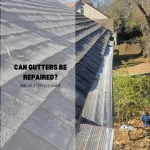Gutter leaks create significant challenges for homeowners by compromising home maintenance integrity. They can lead to water damage, mold growth, erosion, and aesthetic issues. Prompt attention to repairs is vital to preserve property value and structural integrity.
Weather conditions, improper installation, and material degradation primarily cause these leaks, necessitating a comprehensive understanding of repair processes.
Recognizing signs of gutter damage early, such as visible damage, water marks, and signs of mold, is crucial in preventing further deterioration.
Equipping oneself with essential tools like sealants, patches, and safety equipment enables effective repair.
A step-by-step approach, starting with cleaning and followed by sealant application and patching, ensures a thorough repair process.
Moreover, adopting preventive measures, including regular maintenance and the installation of gutter guards, can significantly reduce the likelihood of future leaks.
Understanding when to seek professional help is essential for extensive damage, where DIY efforts might fall short.
This introduction sets the stage for exploring gutter leak repair processes in detail, guiding homeowners through identifying, addressing, and preventing gutter leaks to maintain their homes effectively.
What Causes Gutter Leaks?
Gutter leaks emerge from multiple sources, directly impacting a home’s maintenance regime. Identifying these factors is pivotal for ensuring the longevity and performance of gutter systems.
How Do Weather Conditions Affect Gutters?
Weather plays a significant role in the health of gutter systems. Extreme temperatures, from sweltering heat to freezing cold, can cause gutters to expand and contract, leading to cracks and leaks. Heavy rain and snowfall add weight and pressure, further stressing the gutter structure and potentially causing detachment from the roofline.
The Impact of Improper Installation on Gutter Performance
Improperly installed gutters fail to function as intended. Gutters that are not correctly angled prevent water from flowing seamlessly towards downspouts, leading to water pooling and eventually, leaks. Additionally, gutters installed without adequate spacing for expansion under temperature changes are more likely to crack and leak.
Age and Material Degradation: A Gutter’s Lifespan
The durability of gutters diminishes over time due to material degradation. Factors such as rust in metal gutters, or the breakdown of plastic in PVC gutters, contribute to the formation of leaks. Regular inspection and maintenance are essential to identify age-related wear and tear, ensuring timely repairs or replacement to prevent water damage.
Identifying Common Signs of Gutter Leaks
Recognizing the symptoms of gutter leaks early can prevent significant damage to a home’s foundation and exterior. Homeowners must be vigilant for these indicators to maintain effective gutter performance.
Visible Damage and Water Marks
Visible signs, such as cracks or splits in the gutter, are clear indicators of potential leaks. Water marks beneath the gutters suggest that water is escaping, pointing to leaks that need addressing. These signs often precede more severe damage, making early detection critical.
The Role of Overflowing Water in Leak Detection
Overflowing gutters during rainfall reveal blockages or malfunctions within the gutter system, often associated with leaks. This overflow can lead to water damage on the home’s siding, foundation, and landscaping, signaling the need for gutter inspection and repair.
Mold and Mildew: Indicators of Hidden Leaks
The presence of mold or mildew on the home’s exterior, especially around the gutters, can indicate prolonged exposure to moisture due to leaks. These fungi thrive in damp conditions, often in areas where leaks are not immediately visible, such as behind the gutters against the fascia board. Regular checks for mold and mildew can uncover hidden gutter leaks, allowing for timely remediation.
Essential Tools for Gutter Leak Repair
Effective gutter leak repair requires specific tools and materials. Homeowners equipped with the right tools can efficiently address minor leaks, ensuring their gutter system functions optimally.
Sealants: Types and Applications
Sealants are crucial for repairing leaks in gutters. Silicone or rubber-based sealants offer flexibility and durability, making them ideal for sealing cracks and holes.
Choosing the right sealant depends on the gutter material, with some formulas designed specifically for metal, PVC, or aluminum gutters.
The Importance of Gutter Patches
For larger holes or sections of the gutter that have rusted through, patches made of metal or waterproof material can provide a durable repair solution.
Properly applying a patch over the damaged area, followed by sealant, ensures a watertight repair that restores gutter functionality.
Ladders and Safety Equipment
Safety is paramount when repairing gutters. A stable ladder, preferably with standoff stabilizers, provides safe access to the gutters. Additionally, wearing gloves can protect hands from sharp edges and debris, while safety glasses prevent injury from flying particles. Ensuring personal safety with the appropriate equipment is essential before undertaking any gutter repair tasks.
Step-by-Step Guide to Repairing Gutter Leaks
Addressing gutter leaks involves a methodical approach to ensure repairs are thorough and effective. This guide outlines the necessary steps to identify and fix leaks, enhancing gutter longevity and performance.
Cleaning: The First Step in Leak Repair
Begin with cleaning the gutters to remove debris, leaves, and sediment. This step uncovers hidden damage and allows for a clear assessment of leaks. Using a gutter scoop or a garden hose can facilitate the removal of obstructions, ensuring the gutters are prepared for repair.
Applying Sealant: Techniques for a Watertight Seal
After cleaning, dry the area around the leak thoroughly before applying sealant. For small cracks or holes, apply a bead of gutter sealant on the inside surface to ensure it fully covers the damage. For optimal results, smooth the sealant with a putty knife, creating a seamless barrier against water.
Patching: When and How to Do It
For larger holes, a patch is necessary. Cut a piece of metal or waterproof material slightly larger than the hole. Apply sealant around the edges of the hole, place the patch over the top, and then seal the patch’s edges with more sealant. Ensure the patch adheres firmly and covers the damaged area completely to prevent future leaks.
Preventive Measures to Avoid Future Gutter Leaks
Maintaining a leak-free gutter system requires proactive measures. By implementing preventive strategies, homeowners can significantly reduce the risk of future leaks and extend the lifespan of their gutters.
Regular Maintenance and Cleaning Schedules
Establishing a routine for gutter cleaning and maintenance is essential. Clearing gutters of debris, leaves, and sediment twice a year—typically in the spring and fall—prevents blockages that can lead to leaks. This routine inspection can also identify minor issues before they escalate.
Gutter Guards: Pros and Cons
Installing gutter guards can minimize the accumulation of debris, reducing the need for frequent cleanings. While they offer a practical solution to prevent blockages, it’s important to choose the right type for your gutter system and to be aware that they do not eliminate the need for maintenance entirely.
Professional Inspection: How Often and Why?
Even with diligent maintenance, scheduling professional inspections can uncover issues that are not immediately apparent to homeowners. Experts recommend an annual inspection to ensure gutters are in optimal condition. Professionals can identify potential problem areas and perform necessary repairs, preventing minor issues from becoming costly repairs.
When to Call a Professional for Gutter Repairs
While DIY repairs can address minor gutter issues, certain situations necessitate professional intervention. Knowing when to seek help can save time, ensure safety, and guarantee the longevity of your gutter system.
Assessing the Damage: DIY vs. Professional Repair
Evaluating the extent of gutter damage is crucial. Minor leaks and blockages can often be managed independently. However, significant damage, such as large sections of the gutter system sagging or detaching from the house, requires the expertise of professionals. Their experience and tools allow for comprehensive repairs that go beyond surface-level fixes.
The Benefits of Professional Gutter Maintenance Services
Professional gutter services offer more than just repairs. They can provide thorough cleaning, maintenance, and upgrades to your gutter system. Professionals can also recommend improvements, such as better gutter guards or more suitable materials, based on the specific needs of your home. Investing in professional services can enhance the performance and lifespan of your gutters, ultimately protecting your home from water damage.


